Wired and weird: Meet the cyborg plants
From electrified roses to robotic roots, engineers are taking plants high-tech
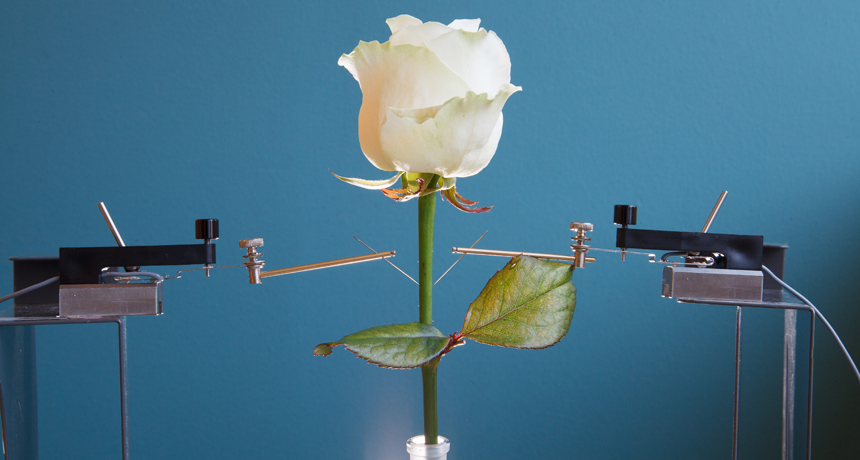
This is no ordinary rose. It is a cyborg! Tiny wires run through its stem, carrying electricity from one metal pin to the other.
Eliot Gomez / Liu
Eleni Stavrinidou wasn’t sure what she’d see when she looked through her microscope at a slice of rose stem. Her team was experimenting with the flowers. They were trying to make a cyborg — a living thing with electronic enhancements. In the past, their attempts had failed to work. But this time was different. She noticed a thin, dark line running up the stem,. It put a grin of excitement on her face.
That dark line was not some natural part of the plant. It was a wire. And it had grown there on its own.
Stavrinidou isn’t the only one turning plants into cyborgs. Several research groups around the world are looking into ways to weave electronics into the natural world. With cutting-edge techniques, they are inserting artificial parts into the plants’ own structures. Such parts can enhance the normal abilities of its hosts. Others may give those plants superpowers.
Plants have the ability to create energy from sunlight. If scientists can harness that, they might one day build a literal “power plant.” They are working to engineer plants in other ways, too. Researchers are turning some into detectors for dangerous materials, from pollutants to bombs. They’re also turning to plants for inspiration. By mimicking certain aspects of leaves and roots, researchers hope to create robots that help monitor the environment — and alert us when conditions start to go bad.
Flower power
One big reason to create cyborg plants: They might capture more energy than Mother Nature’s natural versions.
Green plants take light from the sun and turn it into electrical energy. Normally, that electricity goes to make the sugars the plant needs to grow. This process is called photosynthesis (Foh-toh-SIN-thuh-sis). And it takes place inside the small, walled-off sections of plant cells called chloroplasts (KLOR-oh-plasts). These structures are full of a pigment called chlorophyll (KLOR-oh-fill). Different pigments absorb different colors of visible light. Chlorophyll most strongly absorbs blue and red light. It reflects green, which is what makes these plants look green.
To make energy, the chloroplasts need both carbon dioxide and water. Plants pull in carbon dioxide from the air through tiny holes, called pores, on their leaves. Water travels up from the soil, first through the roots and then through a channel inside the plant stem. That channel, called the xylem (ZY-lem), is where Stavrinidou’s wire grew.
Stavrinidou works in bioelectronics at Linköping University in Sweden. She studies how electronics affect biological functions. Her team had created the wired rose she was peering at under the microscope. And that wire actually worked. It formed a circuit — a path down which electricity could travel. The result was a rose that conducts electricity.
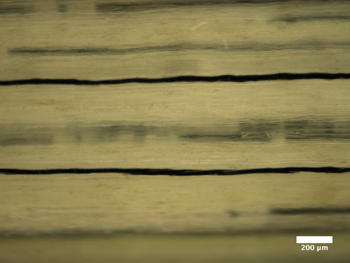
But how did the Linköping team get a wire “grow” inside the rose’s stem? They mixed into water the building blocks needed to make that wire. Then they placed thirsty cut flowers into the water. As each rose drank, it also sucked up molecules of the wire-making material. Once inside the plant’s stem, the molecules stuck together. “They self-organized,” Stavrinidou explains, into a long, thin line.
The material they used was a polymer — a molecule made from a chain of identical, linked segments. Their thin shape makes such molecules ideal for wriggling into small spaces, like the long, narrow vessels that run up and down a plant’s xylem. Polymers form the basis of many materials, such as plastics. But most plastics do not let electricity flow through them. They block it. The PEDOT-S polymer that Stavrinidou used is special because it does conduct electricity. It even can act as a transistor — a switch that stops or starts the flow of electrons. With PEDOT-S, the Linköping group became the first to “build” a transistor inside a flower.
Transistors lie at the heart of every computerized device. The chip inside a mobile phone may contain 2 billion of them. Each transistor can either switch on or off to make a 1 or 0. Computer programs rely on such 1s and 0s to store and handle information.
Engineers make most transistors from metals such as silicon. This electronic rose project, or one like it, might one day lead to living flowers that house working computer chips.
Roses are red, leaves are blue
The Swedish group also is probing other ways to get polymers into plants. In one experiment, they submerged a rose’s leaves into a bath containing another type of PEDOT. The leaves absorbed the polymer, which settled into tiny cavities inside the lower part of the leaf. These cavities stack together in a single layer, looking almost like a piece of bubble wrap.
This PEDOT has a special color-change trait. It converts from dark to light blue as electricity travels through it. To inject electricity, the researchers attached pin-like electrodes. Each electrode pierced a single leaf cavity (think of a single bubble in a sheet of bubble wrap). When the researchers sent juice through the electrode, this tiny region lightened up, while all neighboring ones stayed dark. By attaching many electrodes, the researchers could control which cavities lit up throughout the leaf. This allowed them to create a pixelated display, sort of like the numbers on a digital watch. They published their findings in Science Advances a little more than a year ago.
Stavrinidou hopes that her team’s accomplishments will lead to plants with whole new functions. For instance, scientists might build on her work to imbue plants with inner tools to monitor or even control their growth in farm fields. With tinkering, those plants might be able to use more of the sun’s light. That could cause them to produce flowers, fruits and vegetables faster than normal.
Or, Stavrinidou says: “We could hack into the processes of the plant and take this electricity so people can use it.” Some plants might even host embedded sensors to pick up — and later broadcast — information about the world around them (such as temperature, moisture levels and sunlight).
It’s not quite as easy as that sounds, however. Michael Strano is an engineer at the Massachusetts Institute of Technology in Cambridge. Although a plant hacker, he wasn’t involved in the Linköping projects. But he agrees that capturing and using the electrical energy of plant photosynthesis should be possible.
“Any new capability that you can put into the plant is useful,” he says of the Linköping team’s work. Still, he cautions, the Swedish work is in its infancy. It relied on cut flowers and leaves, not rose bushes rooted in soil. “It’s hard to do these things in a way that keeps the plant viable and growing and thriving,” Strano points out.
That’s something Stavrinidou has learned. Her team has performed tests with leaves attached to growing plants. But cuttings work better, she’s found.
The good news: Adding polymers did not seem to harm her roses or affect the ability of their leaves to make electricity from the sun. Indeed, polymer-infused cuttings survived every bit as long as did those without polymers, she reports.
Tiny technology gives plants a boost
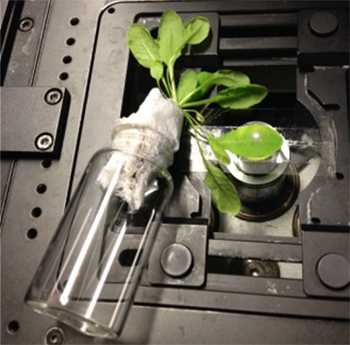
Two years before the Linköping group published its findings, Strano’s team made an exciting discovery. This MIT group found a way to insert extremely tiny machines — nano-machines — into a plant’s chloroplasts. These researchers work in a branch of engineering known as nanotechnology. They study incredibly tiny materials that that operate at very small scales.
Before Strano’s research, scientists had not found a way to get anything through the wall of a plant cell’s chloroplasts. But the MIT team discovered that when it coated tiny particles with electrically charged molecules, chloroplants would suck those particles straight inside. Strano’s team now understood how to insert any tiny particle, material, or even nanomachine into a plant cell.
At last they could begin testing different materials with the goal of altering a plant’s function, such as harvesting sunlight better.
A radio without its antenna can’t capture very clear signals. Similarly, chloroplasts in a regular leaf cannot absorb much of the sun’s light. Plants focus on hues from deep blue to red, ignoring other wavelengths in sunlight. Strano’s team decided to test the creation of a nano-antenna to boost the range of light a plant would capture. Then they inserted it into the chloroplasts of a small flowering weed within the mustard family.
The nano-antenna likely became trapped in the section of the chloroplast that gathers light, the researchers say. And although they still aren’t yet sure exactly how it works, cyborg plants hosting these antennae produced 30 percent more energy from sunlight than normal.
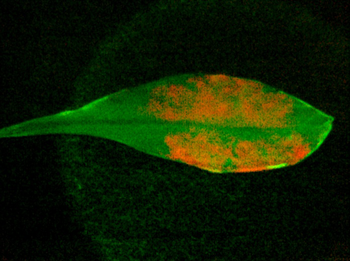
The team published its initial findings three years ago, in Nature Materials. Since then, they’ve begun working to further enhance their plants. For instance, they’ve developed tiny sensors that can detect pollutants and other dangers in groundwater. They also found a way to insert these sensors into living plants.
“A plant has roots that extend into the soil. It is constantly drinking,” Strano says. Any pollutants in the soil or groundwater will get pulled in the way the polymers had been in Stavrinidou’s plants. Sensors within a plant’s roots or xylem should then be able to scout for particular chemicals.
“We made an explosive-detecting plant,” Strano says. Here, the plant’s sensors watched for chemicals in water that betrayed the presence of explosives such as TNT. When the sensors detected a bomb, the plant emitted infrared light. To watch for that signal, The MIT team built a system composed of a camera and a computer. When the camera “saw” the infrared light, the computer emailed out a warning.
Robotic roots
Plant roots inspire scientists in other ways, too. They’re remarkably good at finding water and nutrients while avoiding rocks and other obstacles. These are traits that could be especially useful to robots.
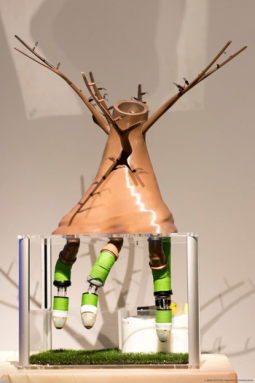
Roots change direction when they run into objects in the soil. Most roots also are covered in sensitive hairs that check for water and nutrients. That’s how they know to grow toward the nutrients a plant needs. Figuring out how they do this could help researchers build better robots.
That’s why roots caught the attention of Barbara Mazzolai. She is a robot specialist at the Italian Institute of Technology in Genoa. Her team has created a robotic plant and begun running it through its paces. Called Plantoid, it has plastic branches with clear leaves. Each leaf contains sensors that measure temperature, touch and other factors. It has trunk, just like a tree. And this system not only can build its own roots but also direct them where to grow.
The tip of each robo-root uses sensors to gather information from its environment. Those sensors measure levels of nearby nutrients, water and pressure. In response, these roots bend away from obstacles and toward nutrients or water.
Some of the roots can even grow. They extend using a process similar to 3D printing. Plantoid feeds plastic thread from a spool through to the root. It stops at a spot just behind the root’s tip. There, the plastic lays down new layers. Over time, this lengthens the root, pushing the tip out and down. A central computer located in Plantoid’s trunk manages the direction of that growth, based on incoming data from its sensor.
Plantoid has several possible uses. When loaded with sensors, its leaves and roots could spy signs of chemicals or pollutants in the air and soil. Plantoid could even travel to other planets and relay back data about alien worlds.
Lessons learned from building plantoid might one day even lead to new tools in medicine, Mazzolai says. A flexible robot that can lengthen itself might help surgeons enter and operate on difficult-to-reach places. For example, the robot might snake down through the mouth and into the stomach.
Nature electrified
For now, robo-roots and cyborg flowers remain laboratory curiosities. But that may change, because farmers and others are curious about what’s going on in the immediate neighborhood of their crops.
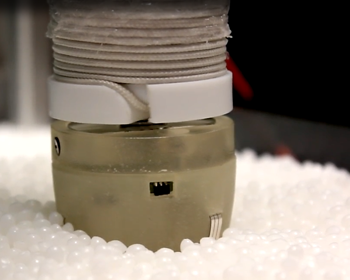
Already many farmers use sensors to monitor crops. These are not part of the plants, but instead are external electronic devices set up at regular intervals across a field or greenhouse. These sensors monitor the air or ground for water, nutrients and other things that matter to plant health. When there’s a problem — dry soil, for example — the sensor sends a wireless alert to a central system. Such a system then alerts farmers about exactly what kind of care their crops need.
Cyborg plants might one day interact with or even replace such sensor systems. Stavrinidou’s wires, Strano’s nanomachines, Plantoid and other similar technologies all turn plants into strange new versions of themselves. Cyborg plants could turn out to be healthier, more powerful or even smarter than regular plants.
One day, people may find it normal to walk past roses that both beautify the street and scan for pollution. At the same time, robots inspired by plants may help explore the surfaces of other planets.
Many people head out into the woods or a garden to get away from technology. But one day soon, nature itself may join our connected, electrified world.







